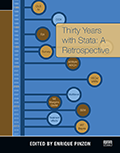New from Stata Press
Stata for the Behavioral Sciences

| Author: |
Michael N. Mitchell |
| Publisher: | Stata Press |
| Copyright: | 2015 |
| ISBN-13: | 978-1-59718-173-0 |
| Pages: | 646; paperback |
| Price: | $68.00 |
Estimated ship date: September 8
Stata for the Behavioral Sciences, by Michael Mitchell, is the ideal reference for researchers using Stata to fit ANOVA models and other models commonly applied to behavioral science data. Drawing on his education in psychology and his experience in consulting, Mitchell uses terminology and examples familiar to the reader as he demonstrates how to fit a variety of models, how to interpret results, how to understand simple and interaction effects, and how to explore results graphically.
Although this book is not designed as an introduction to Stata, it is appealing even to Stata novices. Throughout the text, Mitchell thoughtfully addresses any features of Stata that are important to understand for the analysis at hand. He also is careful to point out additional resources such as related videos from Stata's YouTube channel.
The book is divided into five sections.
The first section contains a chapter that introduces Stata commands for descriptive statistics and another that covers basic inferential statistics such as one- and two-sample t tests.
The second section focuses on between-subjects ANOVA modeling. The discussion moves from one-way ANOVA models to ANCOVA models to two-way and three-way ANOVA models. In each case, special attention is given to the use of commands such as contrast and margins for testing specific hypotheses of interest. Mitchell also emphasizes the understanding of interactions through contrasts and graphs. Underscoring the importance of planning any experiment, he discusses power analysis for t tests, for one- and two-way ANOVA models, and for ANCOVA models.
Section three of the book extends the discussion in the previous section to models for repeated-measures data and for longitudinal data.
The fourth section of the book illustrates the use of the regress command for fitting multiple regression models. Mitchell then turns his attention to tools for formatting regression output, for testing assumptions, and for model building. This section ends with a discussion of power analysis for simple, multiple, and nested regression models.
The final section has a tone that differs from the first four. Rather than focusing on a particular type of analysis, Mitchell describes elements of Stata. He first discusses estimation commands and similarities in syntax from command to command. Then, he details a set of postestimation commands that are available after most estimation commands. Another chapter provides an overview of data management commands. This section ends with a chapter that will be of particular interest to anyone who has used IBM® SPSS®; it lists commonly used SPSS® commands and provides equivalent Stata syntax.
This book is an easy-to-follow guide to analyzing data using Stata for researchers in the behavioral sciences and a valuable addition to the bookshelf of anyone interested in applying ANOVA methods to a variety of experimental designs.
Read the table of contents and order.
Thirty Years with Stata: A Retrospective

| By: |
Enrique Pinzon (editor) |
| Publisher: | Stata Press |
| Copyright: | 2015 |
| ISBN-13: | 978-1-59718-172-3 |
| Pages: | 147; paperback |
This volume is a sometimes serious and sometimes whimsical retrospective of Stata, its development, and its use over the last 30 years.
The view from the inside opens with an essay by Bill Gould, Stata's president and cofounder, that discusses the challenges and concepts that guided the design and implementation of Stata. This is followed by an interview of Bill by Joe Newton that discusses Bill's early interest in computing, his early work on a program for matching prom dates in the days when you had to purchase time on computers, and further exploration of the guiding principles behind Stata. Finally, Sean Becketti, Stata's first employee, delves into the not-to-be-missed culture of Stata in its infancy.The view from the outside comprises 14 essays by prominent researchers and members of the Stata community. Most discuss Stata's use and evolution in disciplines such as behavioral sciences, business, economics, epidemiology, time series, political science, public health, public policy, veterinary epidemiology, and statistics. Some take a sweeping overview. Others are more intimate personal recollections.
Mostly, we simply wanted to celebrate the relationship between Stata users and Stata software. This volume holds something interesting for everyone.
Read the table of contents and order.







